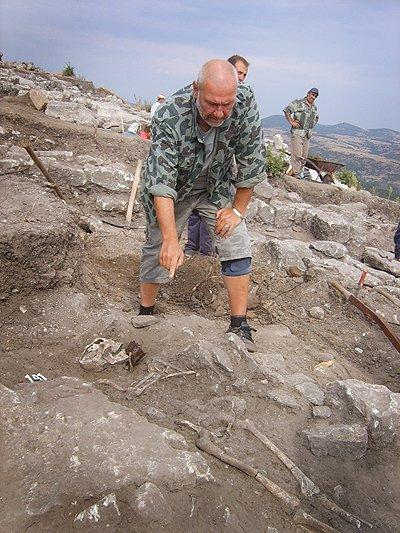This summer Bulgarian archeologists came across vampires too. In early September the team of Prof. Nikolay Ovcharov found remains of an unusual funeral in the archeological site Perperikon, Southeastern Bulgaria. The funeral is of a man aged 35 who had been subject to a series of pagan rituals against vampire-turning. Judging from the bronze coins found by his body, the funeral has been dated to the second half of 13 c. Last year, during excavations at the Sts. Peter & Paul Monastery near Veliko Tarnovo, a necropolis was found displaying remains of a man whose limbs must have been nailed to the ground with metal braces. The fifth brace had been placed on his chest. Embers and bits of flint had been left in his grave too. In traditional beliefs, flint was a substance cutting off the link between the deceased man and those alive.
The man dubbed “vampire” that was found by Prof. Ovcharov is similar to the one dug out in 2012. What they have in common is that they both had been pierced with a ploughshare handle in the area of the collar-bone. “Whoever has read Bram Stoker’s novel about Dracula is aware of happened to him. Dracula’s land of origin was Transylvania – he was in fact the Wallachian Voivode Vlad Tepes who lived in 15 c. We are aware that the whole world is crazy about vampire stories. So I think that we can use this interesting subject – without too much guesswork and exaggeration, of course – to be able to show that a few mysterious rituals were common in the Bulgarian lands. After all, this is interesting for western audiences”, the famous archeologist told a press conference. He pointed to the keen interest of foreign media in the subject of Bulgarian “vampires”.

“Interestingly, at the press conference after the digs on 4 September – though we had found gold objects and other valuable objects – all media had come to find out about the so-called “vampire”. Later I had a call from UK, from Daily Telegraph, willing to shot a film about the new findings. Soon after that The Independent approached me with the same offer, and a few days later their crew was on the excavation site. On 10 September 2013 The Independent carried a one-page article with coverage of the vampire finds and other archeological findings during the summer. In fact, this was only the inception of a wave of articles on this subject. At the end of September I had a call from Charlotte McDonald-Gibson, from the American Time Magazine who arrived to Bulgaria. She wrote the article, Vampire Hunters Descend on Bulgaria that was out on 31 October. In September, an extensive article about Bulgarian vampires was carried by The Daily Mail. Across British and American media, both print and online ones, moved on to publish a dozen articles about the latest archeological sensations in Bulgaria. These media include Global Post, Examiner and Fox News, but also publications in Uganda, Nigeria and Indonesia. Last week, we shot a film with Japan’s second largest national TV channel, Asaka with an audience about 20 million. The shooting took place in November, and the two-hour documentary with the title The Great Phenomena, will be aired this month. It was shot on location in Bulgaria, Serbia and Romania and highlights anti-vampire traditions in this part of Europe”, Prof. Ovcharov explains.
Anti-vampire rituals were performed by the closest family of the deceased person and ethnographic sources argue that such practices survived until the early 20 c. During the funeral common protective actions included tying of limbs, grave fires and covering the dead body with stone blocks. Such funerals date back to prehistory, Prof. Ovcharov says, but during the Middle Ages they were most characteristic of the Balkans. “In Bulgaria, the biggest incidence of such graves is in mountain regions, mostly in Mount Rila and the Rhodope Mountains”, the archeologist goes on to say. “These are places where Christianity had weaker positions against the challenge of staunch paganism. The rituals of this kind were practiced during the Ottoman rule in the Bulgarian lands when Christianity acquired a domesticated nature.” Today we can see a new vampire wave worldwide. “The first one came with the novel Dracula by Bram Stoker at the end of 19 c. Then it was the movie of the same name by Francis Ford Coppola in the 1990s. Now this is the third wave. I was told that there are about 50 books about vampires released over the recent years”.
According to Prof. Nikolay Ovcharov, vampire stories have to do with primitive superstitions but as part of human heritage they have certain value for tourism. People are keen to learn the horrors of the past, and Bulgaria should make the best of this interest.
English version: Daniela Konstantinova